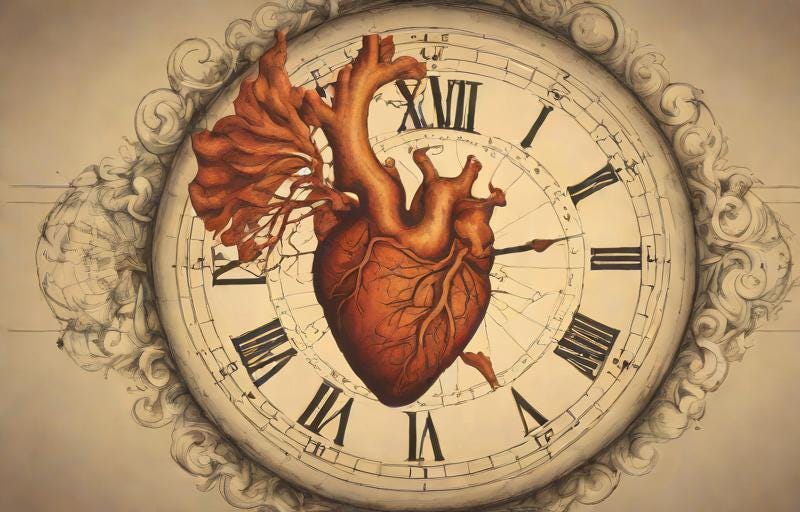Why Nighttime Light Exposure is So Harmful for Cardiovascular Health
Hello darkness my old friend.
Our body’s physiological processes oscillate on a 24-hour cycle known as the circadian rhythm. Circadian rhythms in blood pressure and heart rate, among other functions, are crucial for cardiovascular health and preventing cardiovascular disease. Recent evidence indicates that nighttime light exposure impacts melatonin release, the autonomic nervous system, and cortisol — with potentially harmful effects on cardiovascular health. This post discusses the latest science on the negative effects of artificial light at night (ALAN) on cardiovascular function, the role of physical activity, and implications for health and performance.
Every process in our body happens rhythmically. Day-night oscillations in the release of hormones, body temperature, and a range of other important physiological events orchestrate the complex system that is us. To be human is to experience ebbs and flows, highs and lows.
The most important regulator of our body’s processes is the circadian rhythm — an approximately 24-hour cycle that’s conducted by the central oscillator known as the suprachiasmatic nucleus or SCN. However, we don’t just have one circadian rhythm — every cell in our body has its own circadian rhythm.
The SCN receives information about what’s going on “outside” via the retina, with the main cue being light. Proper entrainment of our body’s circadian rhythms requires that we’re exposed to the right kind of light at the right time of the day. Listeners of the Huberman Lab podcast will be well aware of the importance of morning light exposure for health — it’s not just an off-the-cuff suggestion.
Changes in light-dark cycles including the quality of light, the intensity of light, and the duration and timing of light can disrupt input to the SCN and alter our natural rhythms.
Modern times have permitted constant illumination.
We are not only exposed to natural (and artificial) light during the daytime, but also at night. Artificial light at night — also known as ALAN — is one of the main sources of light input to our SCN. ALAN disrupts our normal light-dark cycles, especially because it’s often accompanied by other circadian disruptors including shift work/night work and jet lag. Food intake and activity at the “wrong” time of the day also lead to circadian disruption.
ALAN can come from streetlamps, billboards, headlights from cars, and buildings. Television screens, computers, and cell phones at night are also a considerable source of ALAN. ALAN is sometimes referred to as “light pollution.” Side note, “noise pollution” is also a modern-day annoyance that’s been shown to negatively affect sleep and cardiovascular health.
ALAN provides information to our SCN — incorrect information that it’s daytime rather than nighttime, that we should be up and active rather than fast asleep.
This has profound implications for cardiovascular health. Because our cardiovascular system also exhibits robust circadian rhythms (for example, the nighttime dip and the morning rise in blood pressure), disruption in these rhythms is a cause of cardiovascular diseases. This is supported by studies showing that ALAN exposure is associated with a range of conditions like cardiometabolic disease, obesity, and diabetes.
How could ALAN and the SCN affect cardiovascular health? Three main pathways predominate: melatonin release, the autonomic nervous system, and the endocrine (hormonal) system.
Light activates the SCN and inhibits melatonin production — remember that melatonin release is necessary in order to fall and stay asleep. In fact, melatonin production from the pineal gland decreases in a dose-response manner to light exposure. The longer you’re on your iPhone before bed, the less melatonin you’ll produce.
ALAN also activates the sympathetic (“fight and flight”) nervous system — the opposite of what we want to happen at night, when parasympathetic activity promotes a restful night of sleep for our body and cardiovascular system. Sympathetic activity also promotes vasoconstriction and an increase in blood pressure, among other cardiovascular effects. The nighttime is a period where our cardiovascular system rests and recovers, and sympathetic activity inhibits this process.
Finally, ALAN can promote the production of glucocorticoids (i.e., “stress hormones” like cortisol). Normally, cortisol rises in the morning and falls at night — this process can be disrupted by nighttime light exposure.
One of the most insidious effects of ALAN is that it reduces the day-night variability in several biological processes. A greater oscillation in blood pressure, heart rate, and hormonal release indicates good health — while a more shallow oscillation may indicate the onset of disease. In other words, we want a strong rise (but not too high) and a large dip in blood pressure from wake to rest.
All of this is to say that we should consider ALAN as a physiological stress. Let’s talk about how ALAN specifically affects cardiovascular health and function and what the implications of this are.1
Cardiovascular effects of nighttime light
Studying the effects of ALAN in well-controlled experimental settings is difficult, and many studies are conducted in older adults living in retirements homes, rehabilitating in hospitals, or in community living settings.
In general, light exposure increases nighttime blood pressure and heart rate. Studies have found that the intensity of light in the bedroom is positively associated with an elevated overnight blood pressure. Hypertension risk increases in a dose-response manner with the intensity of bedroom light.
Autonomic nervous system control of sleep is also affected by nighttime light exposure.
Keep reading with a 7-day free trial
Subscribe to Physiologically Speaking to keep reading this post and get 7 days of free access to the full post archives.




